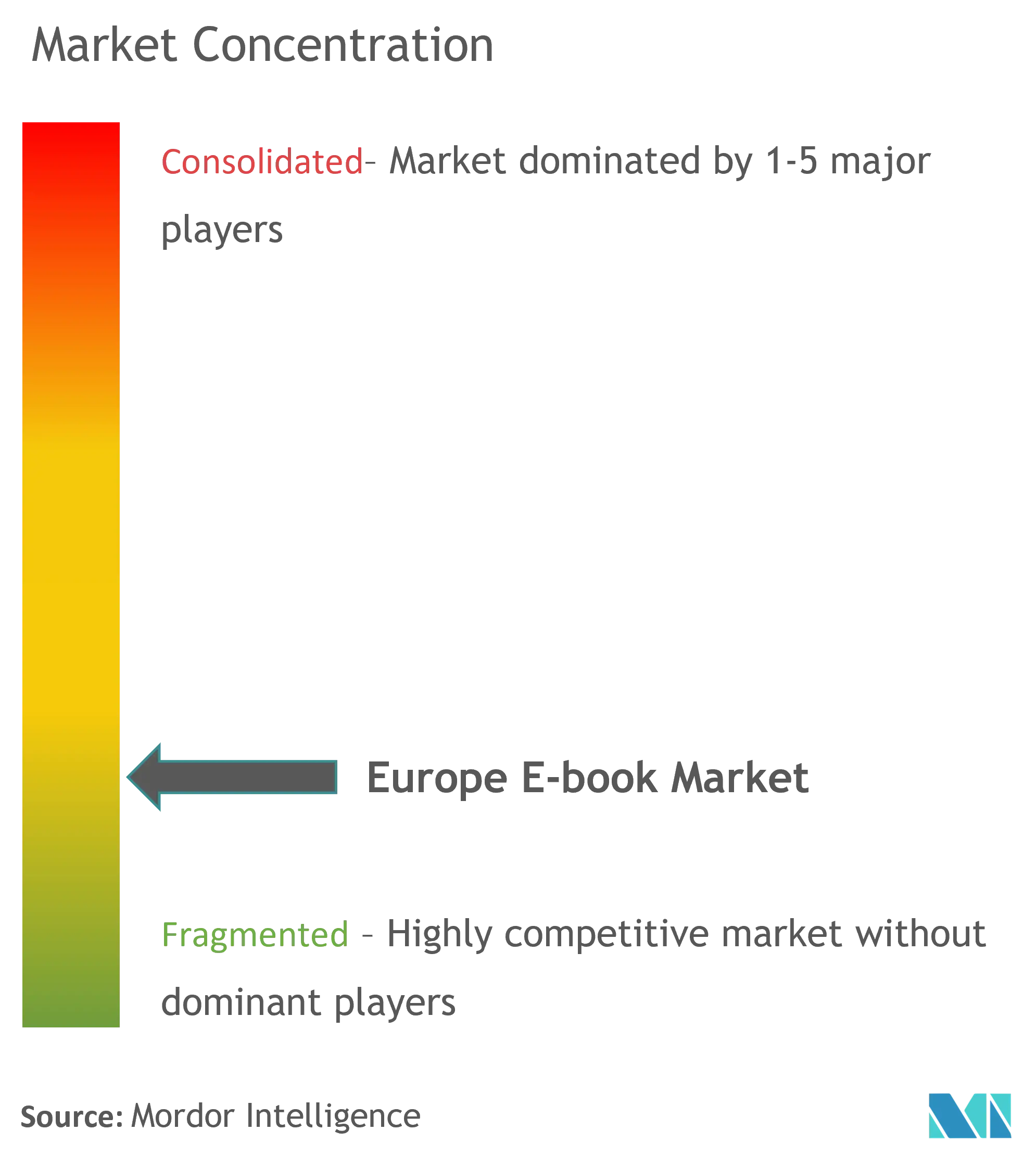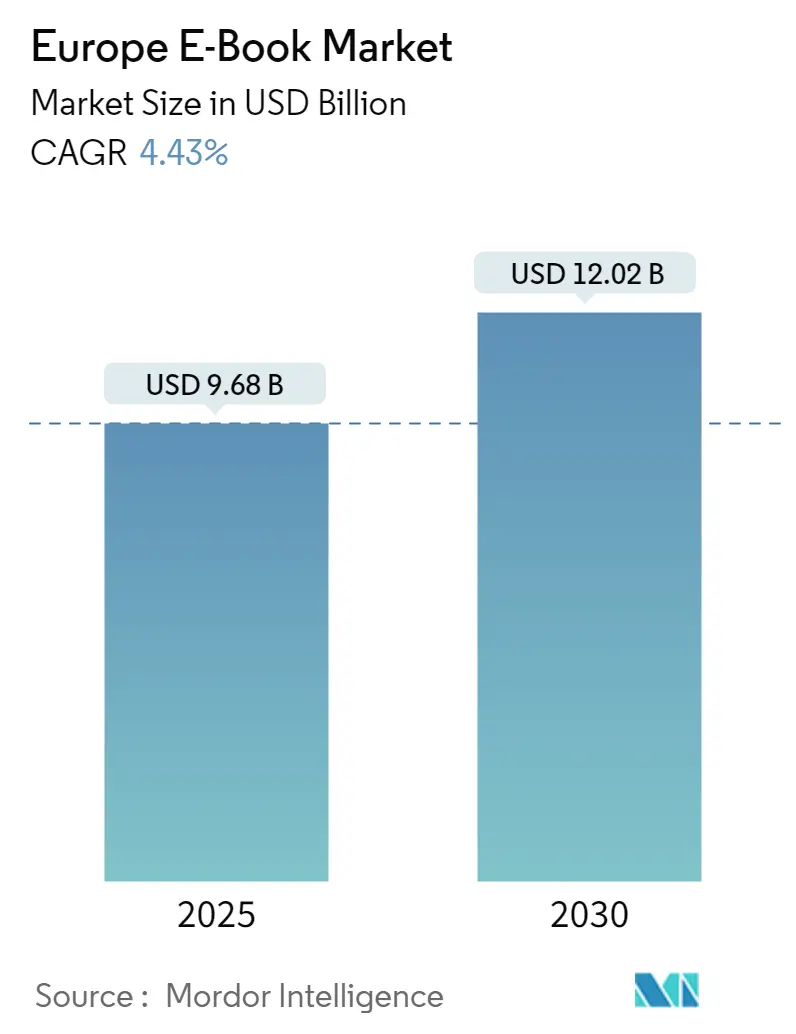Europe E-Book Market Analysis
The Europe E-Book Market size is estimated at USD 9.68 billion in 2025, and is expected to reach USD 12.02 billion by 2030, at a CAGR of 4.43% during the forecast period (2025-2030).
The European e-book landscape is undergoing a significant transformation driven by technological advancement and changing consumer preferences. The widespread availability and rising popularity of e-books are revolutionizing the digital publishing industry, with interactive and animated e-books enabling publishers and authors to bring their works to market faster and more efficiently. The integration of advanced features such as verbal interaction, Augmented Reality (AR), and gaming elements is reshaping the reading experience. This digital evolution is particularly evident in Germany, where approximately 10.3 million individuals engaged with books on electronic devices, demonstrating the growing acceptance of digital reading formats.
The market is witnessing substantial developments in accessibility and pricing strategies across Europe. The implementation of the European Accessibility Act, scheduled for June 2025, will mandate comprehensive accessibility features for e-books, ensuring that all readers can access electronic content regardless of functional impairment. This legislation encompasses the entire production and distribution cycle, requiring publishers to incorporate features such as text-to-speech functionality and compatibility with assistive devices. Price optimization remains a key focus, with Spain leading the way as 87% of e-books are priced below EUR 9.99, making digital literature more accessible to a broader audience.
The industry is experiencing a wave of strategic partnerships and technological innovations aimed at enhancing the reader experience. Notable developments include the launch of hybrid formats combining e-books with audiobooks, as exemplified by Youboox's Switch format. Publishers are increasingly investing in content analytics capabilities to better understand reader behavior and preferences, enabling them to optimize their offerings and marketing strategies. The evolution of color screen technology for e-readers continues to advance, with companies like E INK developing new technologies such as the second-generation Advanced Color e-Paper, promising enhanced reading experiences.
The European digital book market is characterized by significant regulatory reforms and infrastructure developments. Various European countries have implemented VAT reduction initiatives for digital publications, aligning them with their physical counterparts to promote digital reading. The industry is witnessing substantial investments in digital infrastructure, with publishers expanding their digital catalogs and developing more sophisticated distribution platforms. The market is also seeing the emergence of subscription-based models and digital lending services, providing readers with flexible access options while creating new revenue streams for publishers. These developments are supported by the growing integration of digital rights management systems and the standardization of electronic publishing formats across platforms.
Europe E-Book Market Trends
Increasing Internet Penetration Levels and Content Consumption Through Mobile Devices
The proliferation of mobile devices has fundamentally transformed how consumers access and interact with literary content, creating individual points of sale that enable users to browse unlimited selections of books ranging from new releases to backlist titles. According to Ericsson's projections, mobile/cellular subscriptions for mobile PCs, tablets, and routers are expected to reach 78 million in Western Europe and 69 million in Central and Eastern Europe by 2027, indicating substantial growth in potential e-book consumption channels. The increasing adoption of smartphones, tablets, and digital reading devices has created a robust ecosystem for digital reading, with enhanced features such as adjustable brightness controls, customizable text and background colors, and support for multiple file formats including PDF, EPUB, and Mobi.
The publishing industry has responded to this digital transformation by expanding their technological capabilities and distribution channels. Major publishers like Hachette Livre have positioned themselves at the forefront of technical developments and innovations, adapting to evolving reading patterns and consumer behaviors. The integration of advanced features in e-reading applications has made digital content more accessible and user-friendly, with capabilities for transferring files between devices and maintaining synchronized libraries. These technological advancements have created new opportunities for talent scouting and provided authors and illustrators with innovative platforms for creative expression, while ensuring the protection of intellectual property rights and fair value recognition for content creators.
Recent Changes in Consumer Lifestyles Have Led to Increased Consumption Through Nonphysical Means
Modern lifestyle patterns have significantly influenced how consumers engage with literary content, with e-book consumption increasingly aligning with contemporary mobility needs, travel patterns, and daily schedules. The shift towards online reading platforms reflects a broader trend of digitalization across industries, where consumers seek flexible access to content that accommodates their dynamic lifestyles. E-book platforms have evolved to offer features that cater to these changing preferences, including cloud storage capabilities, cross-device synchronization, and instant access to vast libraries of content, making literature more accessible than ever before.
The transformation in consumer behavior has prompted publishers and content providers to expand their digital offerings, with major platforms like Amazon, Google Play Store, Apple iBooks, and Rakuten Kobo developing comprehensive e-book ecosystems. These platforms have introduced innovative features such as customizable reading experiences, integrated note-taking capabilities, and seamless content delivery systems. The industry has witnessed a significant shift in how content is distributed and consumed, with digital platforms offering unprecedented access to both mainstream and niche literary content. This evolution has created new opportunities for publishers to reach broader audiences while providing readers with more convenient and personalized reading experiences that align with their modern lifestyles. The rise of electronic reading and digital content distribution has further accelerated this trend, enhancing the reach and impact of literary works in the digital age.
Europe E-Book Market Geography Segment Analysis
E-Book Market in the United Kingdom
The United Kingdom stands as the cornerstone of Europe's ebook ecosystem, commanding approximately 50% of the total ebook market share in 2024. The country's robust digital infrastructure and progressive regulatory environment have created an ideal foundation for ebook adoption. The UK's ebook landscape is characterized by a sophisticated distribution network, encompassing major platforms and independent publishers alike. The market benefits from the government's continued support through favorable tax policies, including the zero-rated VAT on electronic publications. Libraries across the UK have embraced digital transformation, offering extensive digital library collections and innovative lending services. The academic sector has been particularly responsive to digital content adoption, with universities incorporating digital textbooks into their core curriculum resources. Consumer behavior in the UK shows a strong preference for digital reading platforms, especially among younger demographics who appreciate the convenience and accessibility of ebooks. The market's maturity is reflected in the diverse range of content available, from academic publications to popular fiction, serving readers across all age groups and interests.
E-Book Market in Italy
Italy's ebook market is experiencing remarkable growth, projected to expand at approximately 13% annually from 2024 to 2029. The country's digital publishing landscape is undergoing a significant transformation, driven by increasing consumer acceptance and technological adoption. Italian publishers have been particularly innovative in their approach to electronic literature, incorporating multimedia elements and interactive features that enhance the reading experience. The market has witnessed substantial investments in digital infrastructure and platform development, creating more accessible channels for ebook distribution. Educational institutions across Italy have been instrumental in driving ebook adoption, particularly in higher education where digital textbooks are becoming increasingly prevalent. The country's robust literary tradition has successfully translated into the digital sphere, with both classic and contemporary Italian literature finding new audiences through ebook platforms. Publishers have also focused on developing user-friendly interfaces and improving the overall digital reading experience, contributing to increased consumer adoption rates.
E-Book Market in Germany
Germany's ebook market demonstrates remarkable resilience and sophistication, built on a strong foundation of digital infrastructure and technological innovation. The country's publishing industry has successfully integrated traditional literary values with modern digital distribution methods, creating a balanced ecosystem that serves both conventional and digital readers. German publishers have been particularly successful in maintaining high-quality standards in their digital offerings, ensuring that electronic publications meet the exacting requirements of the German readership. The market benefits from strong institutional support, with libraries and educational establishments actively promoting digital reading initiatives. Consumer behavior in Germany shows an increasing preference for hybrid reading habits, combining both physical and digital formats. The country's robust regulatory framework, including fixed book pricing laws, has helped maintain market stability while promoting fair competition among digital platforms. Publishers have focused on developing specialized content for different market segments, particularly in academic and professional publishing.
E-Book Market in France
France's ebook market exhibits a unique blend of cultural preservation and digital innovation, reflecting the country's commitment to maintaining its rich literary heritage while embracing modern reading formats. The French publishing industry has developed sophisticated digital distribution networks while preserving the traditional value of literature in French society. Publishers have focused on creating high-quality digital content that maintains the aesthetic and intellectual standards associated with French publishing. The market has benefited from strategic partnerships between traditional publishers and technology companies, fostering innovation in digital reading platforms. French educational institutions have played a crucial role in promoting ebook adoption, particularly in higher education and professional training sectors. The country's strong emphasis on cultural policies has helped shape a balanced approach to digital transformation in the publishing industry. Local publishers have successfully developed niche markets for specialized electronic literature, catering to diverse reader interests and academic requirements.
E-Book Market in Other Countries
The ebook markets across other European countries demonstrate diverse growth patterns and adoption rates, each shaped by unique local factors and cultural preferences. Countries like Spain, Russia, the Netherlands, and Poland have developed distinct approaches to digital publishing, reflecting their specific market needs and consumer behaviors. These markets are characterized by increasing investments in digital infrastructure and growing partnerships between local publishers and international platforms. Educational institutions in these regions are progressively incorporating ebooks into their curriculum, driving market growth. The publishing industries in these countries have shown remarkable adaptability in creating localized content while maintaining international standards. Consumer preferences vary significantly across these markets, with some showing strong adoption of subscription-based models while others prefer traditional purchase models. The development of local language content and region-specific platforms has been crucial in these markets, helping to preserve cultural identity while embracing digital transformation.
Europe E-Book Industry Overview
Top Companies in Europe E-Book Market
The European e-book market is dominated by established players, including Amazon's Kindle Direct Publishing, Kobo Inc., Barnes & Noble, Hachette Livre, HarperCollins Publishers, and Penguin Random House. These companies are actively pursuing product innovation through enhanced e-reader technologies, interactive content features, and improved user interfaces. Operational agility is demonstrated through rapid digital transformation initiatives, streamlined digital content delivery systems, and adaptive pricing models. Strategic moves in the market include significant investments in audiobook capabilities, the development of subscription-based services, and the integration of artificial intelligence for personalized reading experiences. Market leaders are expanding their presence through strategic partnerships with local publishers, educational institutions, and technology providers, while also focusing on building direct-to-consumer relationships through proprietary platforms and applications.
Consolidated Market with Strong Digital Focus
The European e-book market exhibits a relatively consolidated structure dominated by global publishing conglomerates and specialized digital publishing content providers. These major players leverage their extensive content libraries, technological capabilities, and established distribution networks to maintain market leadership. The market is characterized by a mix of traditional publishing houses that have successfully digitized their operations and pure-play digital platforms that specialize in electronic publication distribution. Merger and acquisition activity has been particularly notable, with larger players acquiring smaller, innovative companies to enhance their digital capabilities and expand their market reach.
The competitive dynamics are shaped by the increasing integration between content creation, distribution platforms, and device ecosystems. Major publishing houses are strengthening their positions through vertical integration, while technology companies are expanding into content creation and publishing services. The market has witnessed significant consolidation through strategic acquisitions, particularly in areas such as audiobook production, self-publishing platforms, and educational content providers, as companies seek to build comprehensive digital content ecosystems.
Innovation and Adaptation Drive Market Success
For incumbent players to maintain and increase their market share, the focus needs to be on continuous technological innovation, content diversification, and enhanced user experience. Companies must invest in developing proprietary technologies, expanding their digital content libraries, and creating value-added services such as personalized recommendations and interactive features. Building strong relationships with authors, educational institutions, and content creators while maintaining competitive pricing strategies will be crucial for sustained growth. Additionally, incumbents need to strengthen their position in emerging segments such as educational e-books and specialized professional content.
Market contenders can gain ground by focusing on niche markets, developing specialized content offerings, and leveraging innovative distribution models. Success factors include building strong technological capabilities, establishing strategic partnerships with content creators, and developing unique value propositions for specific user segments. The regulatory landscape, particularly regarding digital rights management and pricing policies, will continue to influence market dynamics. Companies must also address the growing threat of digital piracy while maintaining competitive pricing strategies to minimize substitution risks from alternative content formats and platforms. The rise of digital literature and electronic content formats is also reshaping consumer preferences and demands.
Europe E-Book Market Leaders
-
Kindle Direct Publishing (Amazon.com)
-
Rakuten Kobo Inc.
-
Barnes & Noble Inc.
-
Lulu Press Inc.
-
Georg von Holtzbrinck GmbH & Co. KG
- *Disclaimer: Major Players sorted in no particular order

Europe E-Book Market News
- September 2023 - Pearson today launched its GSL - a first of its kind scale which will bring unparalleled clarity and simplicity to language learning in different languages. The Global Scale of Languages will initially cover French, Italian and Spanish, with German and other languages to follow, where Students benefit as they can now pinpoint their proficiency in different languages on a common scale, set themselves personalised learning targets and benchmark progress as they move from beginner to fluency.
- March 2023: Koji launched a tool for selling e-books. The tool will also assist users in selling audiobooks and e-books on social media platforms and the web. Readers can download their purchase and view it on Koji's native reader, audio player, and other apps like Amazon kindle.
- February 2023: Spotify launched its audiobook service in UK and Ireland. Consumers in these markets will have access to around 0.3 million titles like those in the US market. The key features will include downloading titles for offline listening, rating titles, adjusting the playback speed, and listening across devices.
- January 2023: Europe Comics announced its exit from online publicity presence, which means the publisher will no longer be active on the website, social media, newsletters, and events. The book release will continue and be available to consumers through preferred online retailers.
- October 2022: BootBeat, the provider of e-books in Europe, expanded its services in Italy and Spain. For further business expansion, Boot beat is looking forward to collaborating with local publishers so that users can access a constantly expanding catalog of front and backlist titles.
Europe E-Book Industry Segmentation
An E-Book, or electronic book, is a text that is presented in digital format. This text remains non-editable, and the user needs an electronic device like a smartphone, tablet, or desktop to read this displayed text. These e-books can be accessed through multiple devices, most downloadable. From the author's perspective, e-books reduce production costs as they are not required to be printed. Portability and surging internet demand are favoring the e-books business.
The Europe e-books market is segmented by content type (professional, educational, general), device type (smartphone, tablet) and geography (Germany, United Kingdom, France, Spain, Russia, Italy, Netherlands, Poland, Rest of the Europe) The market sizes and forecasts are provided in terms of value (USD).
| By Content | Professional |
| Educational | |
| General | |
| By device type | Smartphone |
| Tablet | |
| Geography | Germany |
| United Kingdom | |
| France | |
| Spain | |
| Russia | |
| Italy | |
| Netherlands | |
| Poland | |
| Rest of the Europe |
| Professional |
| Educational |
| General |
| Smartphone |
| Tablet |
| Germany |
| United Kingdom |
| France |
| Spain |
| Russia |
| Italy |
| Netherlands |
| Poland |
| Rest of the Europe |
Europe E-Book Market Research FAQs
How big is the Europe E-Book Market?
The Europe E-Book Market size is expected to reach USD 9.68 billion in 2025 and grow at a CAGR of 4.43% to reach USD 12.02 billion by 2030.
What is the current Europe E-Book Market size?
In 2025, the Europe E-Book Market size is expected to reach USD 9.68 billion.
Who are the key players in Europe E-Book Market?
Kindle Direct Publishing (Amazon.com), Rakuten Kobo Inc., Barnes & Noble Inc., Lulu Press Inc. and Georg von Holtzbrinck GmbH & Co. KG are the major companies operating in the Europe E-Book Market.
What years does this Europe E-Book Market cover, and what was the market size in 2024?
In 2024, the Europe E-Book Market size was estimated at USD 9.25 billion. The report covers the Europe E-Book Market historical market size for years: 2019, 2020, 2021, 2022, 2023 and 2024. The report also forecasts the Europe E-Book Market size for years: 2025, 2026, 2027, 2028, 2029 and 2030.




